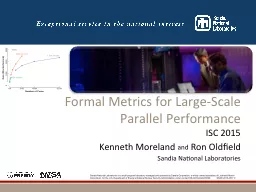

ISC 2015 Kenneth Moreland and Ron Oldfield Sandia National Laboratories Parallel Algorithm Speedup Parallel Algorithm Speedup Serial time for large problem sizes Cannot be measured in practice ID: 283552
Download Presentation The PPT/PDF document "Formal Metrics for Large-Scale Parallel ..." is the property of its rightful owner. Permission is granted to download and print the materials on this web site for personal, non-commercial use only, and to display it on your personal computer provided you do not modify the materials and that you retain all copyright notices contained in the materials. By downloading content from our website, you accept the terms of this agreement.
Slide1
Formal Metrics for Large-Scale Parallel Performance
ISC 2015Kenneth Moreland and Ron OldfieldSandia National LaboratoriesSlide2
Parallel Algorithm SpeedupSlide3
Parallel Algorithm Speedup
Serial time for large problem sizes
Cannot be measured in practiceSlide4
EfficiencySlide5
EfficiencySlide6
Karp-Flatt
MetricSlide7
Isoefficiency MetricSlide8
Measuring Scalability in Practice
Strong Scaling: Behavior as processing elements are increased and problem size held constant.Per Amdahl’s Law, strong scaling always has its limits.Weak Scaling: Behavior as processing elements and job size are increased proportionally.
Per Gustafson-Barsis Law, weak scaling can possibly be increased indefinitely.Scaling is often demonstrated with absolute run time over different scales.Slide9
Demonstrating Strong ScalingSlide10
Measuring Strong Scaling
O(
n
/
p
)
O(
n
/
p
+ log
p
)
O(
n
/
p
+
p
)Slide11
Strong Scaling with Log AxesSlide12
Measuring Strong Scaling with Log
O(
n
/
p
)
O(
n
/
p
+ log
p
)
O(
n
/
p
+
p
)Slide13
Scaling with More Visual Precision
Our position statement: rate and efficiency better represent scaling behavior.Although neither rate nor efficiency is a new concept, there is not a lot of consistency in the community.Through algebra and examples I will show why rate and efficiency are the “right” metrics to use.Slide14
RateSlide15
Why Use Rate?Slide16
Why Use Rate?Slide17
Why Use Rate?
Becomes a constant with
n
is constant.Slide18
Why Use Rate?Slide19
Scaling with RateSlide20
Measuring Scaling with Rate
O(
n
/
p
)
O(
n
/
p
+ log
p
)
O(
n
/
p
+
p
)Slide21
Measuring Scaling with Rate
O(
n
/
p
+ log
p
)
O(
n
/
p
+
p
)
O(
n
/
p
+ log
p
)
O(
n
/
p
+
p
)Slide22
EfficiencySlide23
Measuring Efficiency from CostSlide24
Measuring Efficiency from Cost
Minimum (best) costSlide25
Scaling with EfficiencySlide26
Measuring Scaling with Efficiency
O(
n
/
p
+ log
p
)
O(
n
/
p
+
p
)
O(
n
/
p
+ log
p
)
O(
n
/
p
+
p
)Slide27
[This Slide Left Intentionally Blank]Slide28
Unifying Strong and Weak ScalingSlide29
Unifying Strong and Weak ScalingSlide30
Unifying Strong and Weak ScalingSlide31
Efficiency Across Data ScalesSlide32
Unifying Rate Across Data ScalesSlide33
Unifying Rate Across Data ScalesSlide34
Unifying Rate Across Data ScalesSlide35
Rate Across Data ScalesSlide36
Use Case 1: Gordon Bell Finalist
Measurements of HACC code performanceExcellent ScalabilityMeasurements across many scalesLots of data provided in paperSlide37
Use Case 1: Gordon Bell FinalistSlide38
Use Case 1: Gordon Bell FinalistSlide39
Use Case 1: Gordon Bell FinalistSlide40
Use Case 1: Gordon Bell FinalistSlide41
Use Case 1: Gordon Bell FinalistSlide42
Use Case 2: Imperfect Scaling
Measures visualization algorithmA high communication overhead severely limits scalabilitySlide43
Use Case 2: Imperfect ScalingSlide44
Use Case 2: Imperfect ScalingSlide45
Use Case 2: Imperfect ScalingSlide46
Final Recommendations
Do not rely on running time for performance analysis. Instead use rate, efficiency, or both.Avoid using log-log scaling on plot axes, which hides
major inefficiencies. If necessary, repeat linear plots at different scales.Rather than performing them separately, incorporate
weak and strong scaling studies
in
one
. Perform several strong scaling studies
at different
scales of data size. Then find an overall minimal
practical
cost per unit and plot all the measurements together as demonstrated
in
the figures in this paper.Slide47
Acknowledgements
This material is based in part upon work supported by the U.S. Department of Energy, Office of Science, Office of Advanced Scientific Computing Research, Scientific Discovery through Advanced Computing (SciDAC
) program under Award Number 12-015215.This material is based in part upon work supported by the U.S. Department of Energy, National Nuclear Security Administration, Advanced Simulation and Computing (ASC).